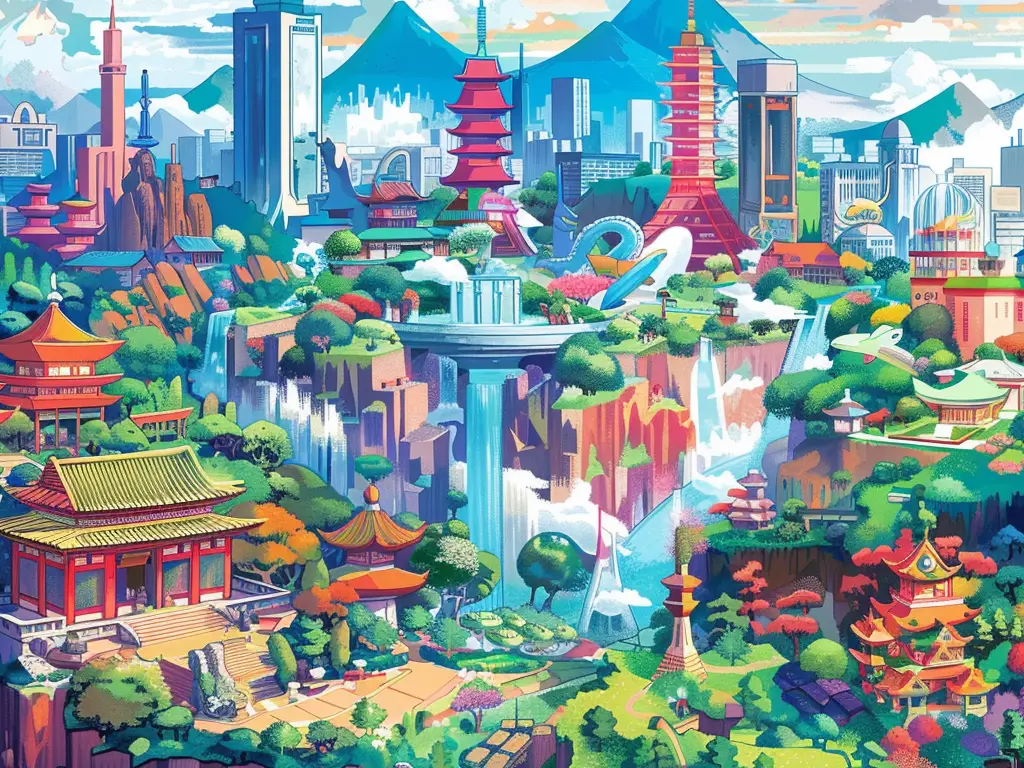From Kanto to Galar: The Cultural Influences of Pokémon Regions

Pokémon has a rich and diverse universe, so much so that each region has been carefully designed to offer players a unique experience. What is fascinating is that these regions do not come from nowhere; they are often inspired by real places and cultural aspects of the world around us. From geography to local traditions, through architecture and customs, the creators of Pokémon have skillfully integrated these elements into their design of the regions.
Kanto: A Nod to Japan's Kantō Region
The first region players discover is Kanto, inspired by the Kantō region in Japan. The geography, cities, and even some cultural characteristics reflect this inspiration. For example, Saffron City and its skyscrapers resemble Tokyo, while Celadon City is inspired by the bustling shopping districts of Shibuya and Harajuku.
Johto: A Homage to Japanese Traditions
Johto, introduced in the second generation of games, is deeply rooted in Japan's traditions and history. The region draws its inspiration from the Kansai region, known for its many historical temples and shrines. The Tin Tower and the Burned Tower, two iconic sites in Johto, recall the historic Japanese structures. The themes of nature, legends, and ancestral traditions are omnipresent, making Johto a region particularly rich in culture.
Hoenn: A Blend of Tropical Landscapes and Cultural Diversity
Hoenn is a region introduced in the Pokémon Ruby and Sapphire games. This region is greatly inspired by the Japanese island of Kyūshū and offers a variety of postcard landscapes (volcanoes, tropical beaches, dense forests, and swamp areas). This geographical diversity is a reflection of the variety of landscapes in Kyūshū. Additionally, the local culture, with its maritime traditions and festivals, greatly influences the design of Hoenn.
Sinnoh: The Region of Mountains and Myths
Inspired by the island of Hokkaido, Sinnoh is characterized by its imposing mountains and its roots in ancient legends. Mount Coronet, which dominates the region, is a direct parallel with the volcanic mountains of Hokkaido. The legends surrounding Legendary Pokemon like Dialga and Palkia add mythological depth to the region, reminiscent of the old tales and myths of Japanese culture.
Unova: A Journey Across the Atlantic
The region of Unova, introduced in Pokémon Black and White, is notably inspired by New York City and its surroundings. It is the first region to move away from purely Japanese inspirations to embrace a Western metropolis. The skyscrapers of Castelia City, the bridges, and various neighborhoods faithfully reflect the New York atmosphere, while integrating elements of American culture.
Kalos: An Escape to France
Inspired by France, Kalos is introduced in the Pokémon X and Y games and is distinguished by its French-style architecture, its charming little cafes, and its completely bucolic landscapes. Everything here echoes the beauty and charm of the French countryside. Lumiose City, the capital of Kalos, is a direct nod to Paris, with its iconic Eiffel Tower known as the Prism Tower in the game. The creators also drew inspiration from France's rich culture and history in the design of Kalos' cities and traditions.
Alola: The Tropical Paradise of Hawaii
The region of Alola, introduced in the Pokémon Sun and Moon games, is entirely inspired by Hawaii. The lush islands of Alola, with their paradisiacal beaches, (active!) volcanoes, and exotic wildlife, unmistakably refer to the Hawaiian archipelago. The Hawaiian culture, with its traditional dances, festivals, and laid-back lifestyle, is reflected in the interactions and customs of Alola's inhabitants.
Galar: A Tour of Great Britain
The region of Galar, introduced in Pokémon Sword and Shield, is heavily inspired by Great Britain. The varied landscapes, from lush hills to industrial cities, reflect the geographical diversity of the United Kingdom. The Pokémon stadiums, reminiscent of English football stadiums, the character clothing, and even the cuisine are nods to British culture.
Each region in the Pokémon universe pays homage and reference - to varying degrees - to the cultures and landscapes of the real world. Pokémon creators have shown care, subtlety, and coherence in their integration of cultural, historical, and geographical elements to create rich and immersive environments, which strongly resonate with fans around the world. This approach not only diversifies and gives uniqueness to the stories but also offers players a constant journey through varied cultural inspirations. This greatly contributes to the universality of Pokémon, allowing everyone to find and marvel at the carefully crafted details of each region.
